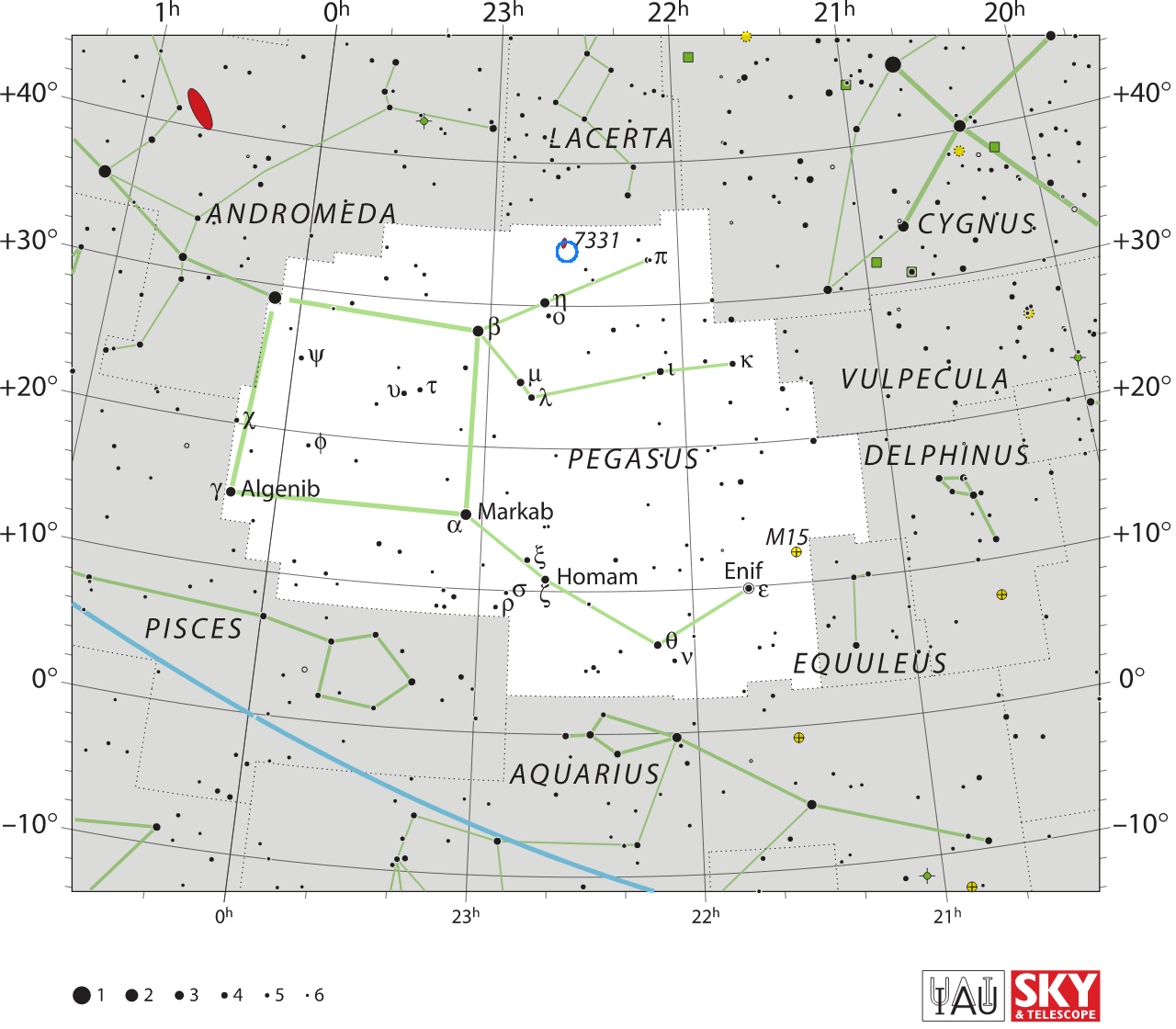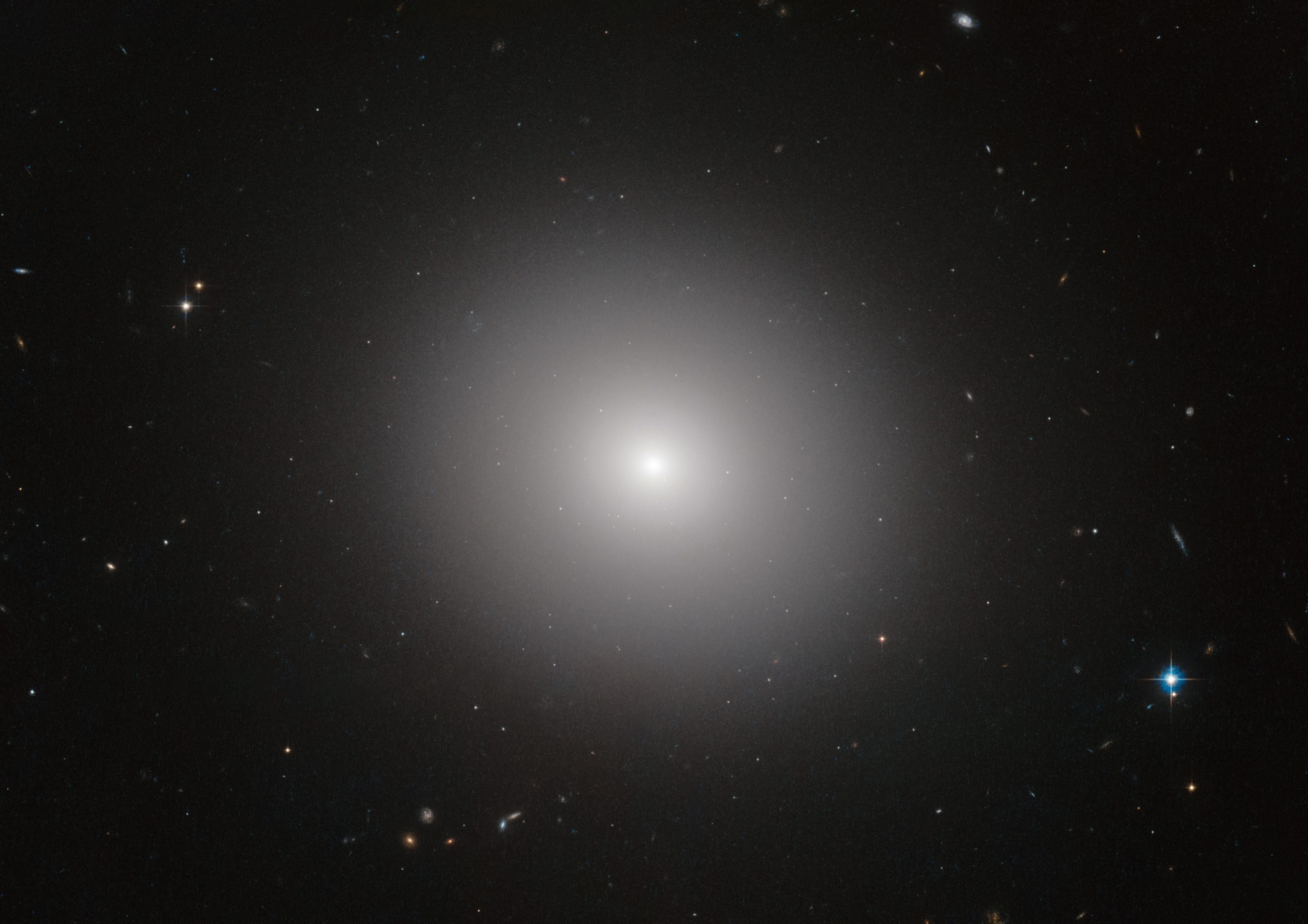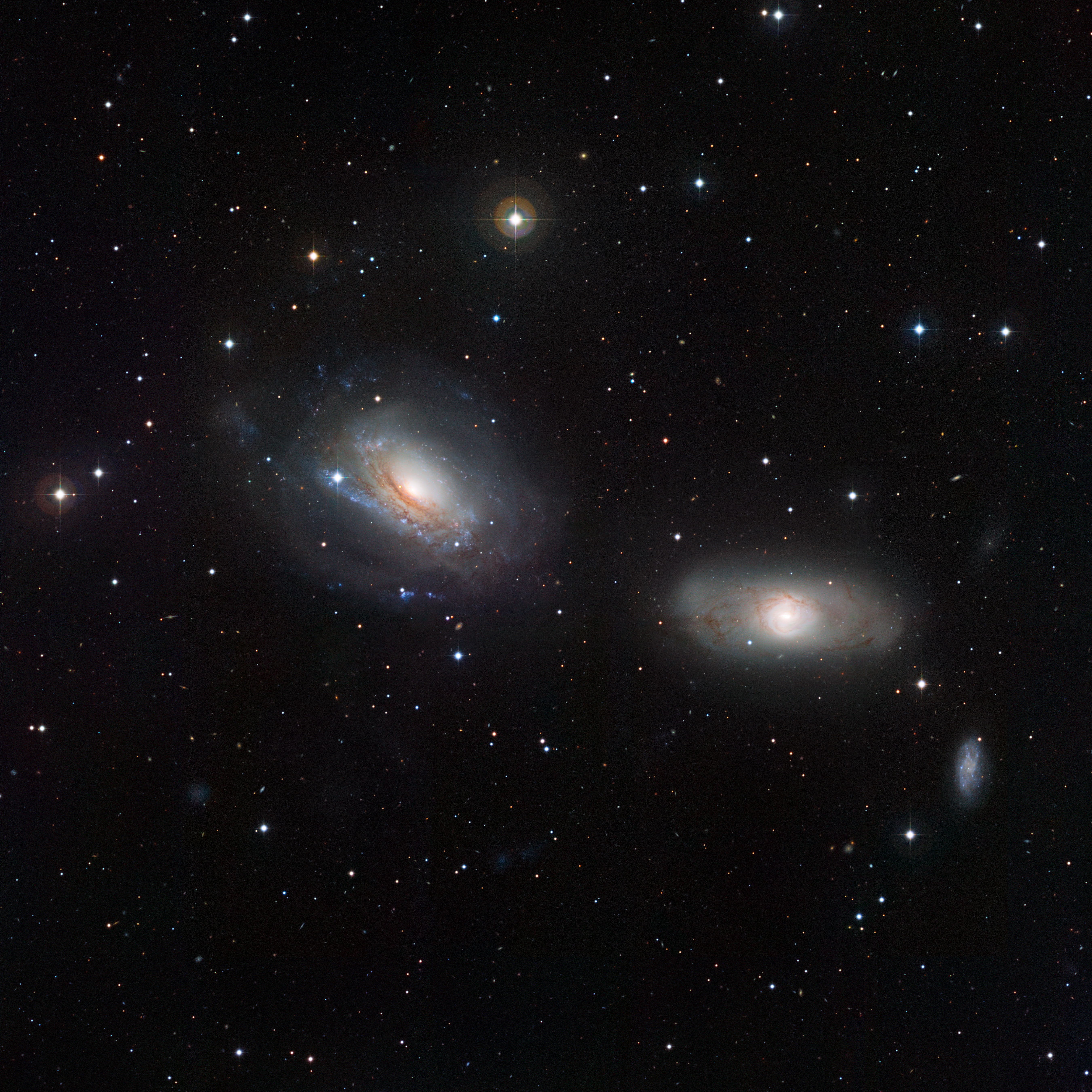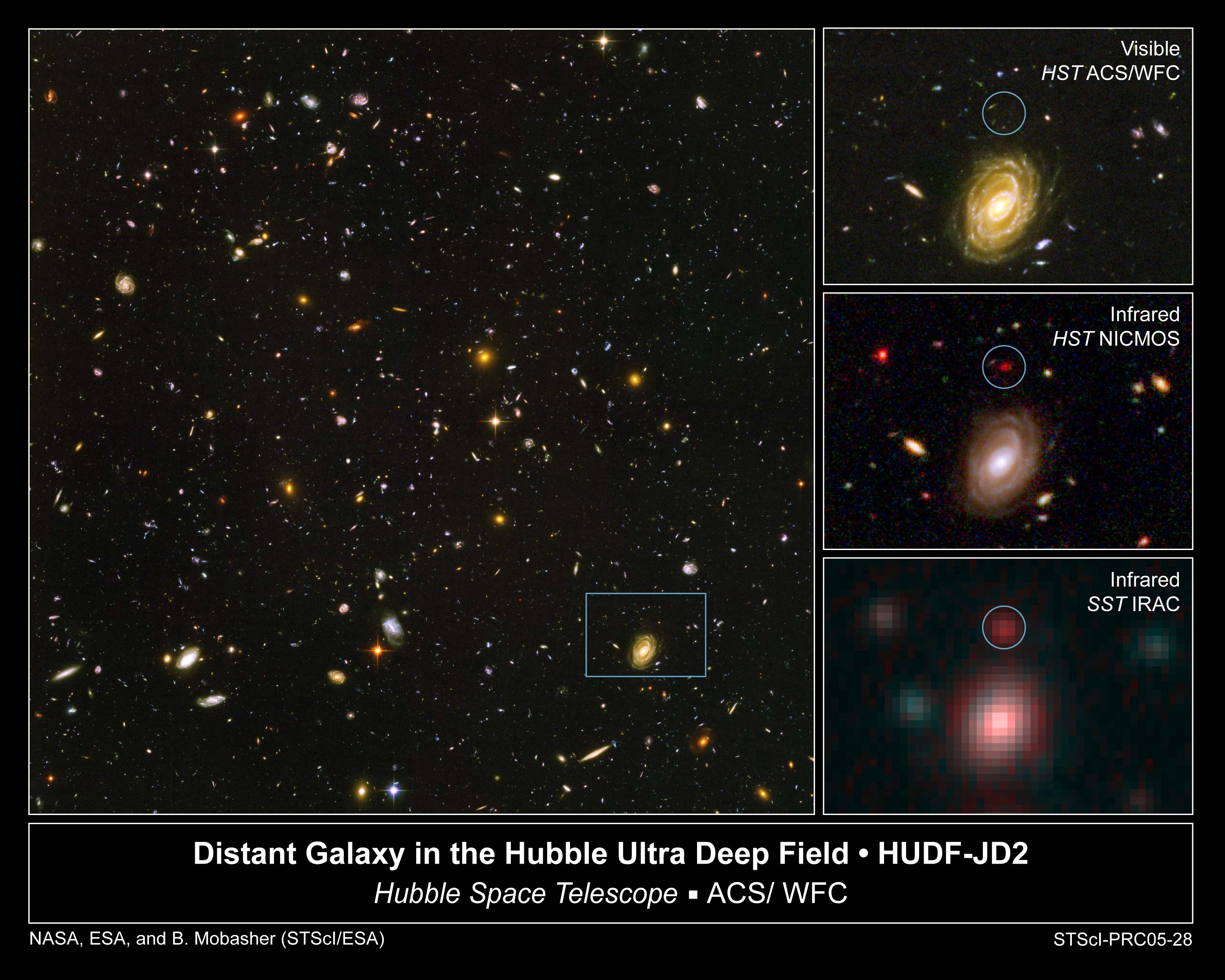|
NGC 7318
NGC 7318 (also known as UGC 12099/UGC 12100 or HCG 92d/b) is a pair of colliding galaxies about 280 million light-years from Earth. They appear in the Constellation Pegasus and are members of Stephan's Quintet. They were discovered on 27 September 1873 by French astronomer Édouard Stephan. The Spitzer Space Telescope revealed the presence of a large intergalactic shock wave, shown by an arc produced by NGC 7318b colliding with the group at ≥ 900 km/sec. As NGC 7318b collides with NGC 7318a, atoms of hydrogen in the cluster's gas are heated by the shock wave, producing the green glow. The molecular hydrogen visible in the collision is one of the most turbulent forms known. This phenomenon was discovered by an international team of scientists of the Max Planck Institute for Nuclear Physics (MPIK) in Heidelberg. This collision can help provide a view into what happened in the early universe, around ten billion years ago. See also * List of NGC objects (7001–7840) Ref ... [...More Info...] [...Related Items...] OR: [Wikipedia] [Google] [Baidu] |
New General Catalogue
The ''New General Catalogue of Nebulae and Clusters of Stars'' (abbreviated NGC) is an astronomical catalogue of deep-sky objects compiled by John Louis Emil Dreyer in 1888. The NGC contains 7,840 objects, including galaxy, galaxies, star clusters and emission nebulae. Dreyer published two supplements to the NGC in 1895 and 1908, known as the ''Index Catalogues'' (abbreviated IC), describing a further 5,386 astronomical objects. Thousands of these objects are best known by their NGC or IC numbers, which remain in widespread use. The NGC expanded and consolidated the cataloguing work of William Herschel, William and Caroline Herschel, and John Herschel's ''General Catalogue of Nebulae and Clusters of Stars''. Objects south of the Celestial sphere, celestial equator are catalogued somewhat less thoroughly, but many were included based on observation by John Herschel or James Dunlop. The NGC contained multiple errors, but attempts to eliminate them were made by the ''Revised New Ge ... [...More Info...] [...Related Items...] OR: [Wikipedia] [Google] [Baidu] |
Constellation
A constellation is an area on the celestial sphere in which a group of visible stars forms Asterism (astronomy), a perceived pattern or outline, typically representing an animal, mythological subject, or inanimate object. The first constellations were likely defined in prehistory. People used them to relate stories of their beliefs, experiences, creation myth, creation, and mythology. Different cultures and countries invented their own constellations, some of which lasted into the early 20th century before today's constellations were internationally recognized. The recognition of constellations has changed significantly over time. Many changed in size or shape. Some became popular, only to drop into obscurity. Some were limited to a single culture or nation. Naming constellations also helped astronomers and navigators identify stars more easily. Twelve (or thirteen) ancient constellations belong to the zodiac (straddling the ecliptic, which the Sun, Moon, and planets all traver ... [...More Info...] [...Related Items...] OR: [Wikipedia] [Google] [Baidu] |
UGC Objects
UGC may refer to: Organisations * Canadian Geophysical Union, official abbreviation in French (Union géophysique canadienne) * UGC (cinema operator), a European cinema chain, formerly Union Générale Cinématographique * UGC Fox Distribution, a former French-American film production company formed in 1995 * Union Graduate College, Schenectady, New York * United Grain Company, a Russian grain trading company based in Moscow * University Grants Commission (other) * University Grants Committee (other) * UnitedGlobalCom, former name of the cable TV operator Liberty Global * UnderGround Crips, an African American street gang mainly from Los Angeles, California Science and technology * Universal gravitational constant G, in physics * Uppsala General Catalogue, an astronomical catalogue of galaxies * UGC, a codon for cysteine * Unique games conjecture, a conjecture in computational complexity Other * User-generated content User-generated content (UGC), a ... [...More Info...] [...Related Items...] OR: [Wikipedia] [Google] [Baidu] |
NGC Objects
The ''New General Catalogue of Nebulae and Clusters of Stars'' (abbreviated NGC) is an astronomical catalogue of deep-sky objects compiled by John Louis Emil Dreyer in 1888. The NGC contains 7,840 objects, including galaxies, star clusters and emission nebulae. Dreyer published two supplements to the NGC in 1895 and 1908, known as the ''Index Catalogues'' (abbreviated IC), describing a further 5,386 astronomical objects. Thousands of these objects are best known by their NGC or IC numbers, which remain in widespread use. The NGC expanded and consolidated the cataloguing work of William and Caroline Herschel, and John Herschel's '' General Catalogue of Nebulae and Clusters of Stars''. Objects south of the celestial equator are catalogued somewhat less thoroughly, but many were included based on observation by John Herschel or James Dunlop. The NGC contained multiple errors, but attempts to eliminate them were made by the ''Revised New General Catalogue'' (RNGC) by Jack W. ... [...More Info...] [...Related Items...] OR: [Wikipedia] [Google] [Baidu] |
Peculiar Galaxies
A peculiar galaxy is a galaxy A galaxy is a Physical system, system of stars, stellar remnants, interstellar medium, interstellar gas, cosmic dust, dust, and dark matter bound together by gravity. The word is derived from the Ancient Greek, Greek ' (), literally 'milky', ... of unusual size, shape, or composition. Between five and ten percent of known galaxies are categorized as peculiar. Astronomers have identified two types of peculiar galaxies: ''interacting galaxies'' and ''active galactic nuclei'' (AGN). When two galaxies come close to each other, their mutual gravitational forces can cause them to acquire highly irregular shapes. The terms 'peculiar galaxy' and 'interacting galaxy' have now become synonymous because the majority of peculiar galaxies attribute their forms to such gravitational forces. Formation Scientists hypothesize that many peculiar galaxies are formed by the collision of two or more galaxies. As such, peculiar galaxies tend to host more activ ... [...More Info...] [...Related Items...] OR: [Wikipedia] [Google] [Baidu] |
Elliptical Galaxies
An elliptical galaxy is a type of galaxy with an approximately ellipsoidal shape and a smooth, nearly featureless image. They are one of the three main classes of galaxy described by Edwin Hubble in his Hubble sequence and 1936 work ''The Realm of the Nebulae'', with their intermediate scale disks, a subset of the "early-type" galaxy population. Most elliptical galaxies are composed of older, low-mass stars, with a sparse interstellar medium, and they tend to be surrounded by large numbers of globular clusters. Star formation activity in elliptical galaxies is typically minimal; they may, however, undergo brief periods of star formation when merging with other galaxies. Elliptical galaxies are believed to make up approximately 10–15% of galaxies in the Virgo Supercluster, and they are not the dominant type of galaxy in the universe overall. They are preferentially found close to the centers of galaxy clusters. Elliptical galaxies range in size from dwarf ellipticals with ... [...More Info...] [...Related Items...] OR: [Wikipedia] [Google] [Baidu] |
Interacting Galaxies
Interacting galaxies (''colliding galaxies'') are galaxies whose gravitational fields result in a disturbance of one another. Major mergers occur between galaxies with similar amounts of mass, whereas minor mergers involve galaxies with masses that vary significantly. An example of a minor interaction is a satellite galaxy disturbing the primary galaxy's spiral arms. An example of a major interaction is a galactic collision, which may lead to a galaxy merger. Satellite interaction A giant galaxy interacting with its satellites is common. A satellite's gravity could attract one of the primary's spiral arms. Alternatively, the secondary satellite can dive into the primary galaxy, as in the Sagittarius Dwarf Elliptical Galaxy diving into the Milky Way. That can possibly trigger a small amount of star formation. Such orphaned clusters of stars were sometimes referred to as "blue blobs" before they were recognized as stars. Galaxy collision Colliding galaxies are common during ... [...More Info...] [...Related Items...] OR: [Wikipedia] [Google] [Baidu] |
Barred Spiral Galaxies
A barred spiral galaxy is a spiral galaxy with a central bar-shaped structure composed of stars. Bars are found in about two thirds of all spiral galaxies in the local universe, and generally affect both the motions of stars and interstellar gas within spiral galaxies and can affect spiral arms as well. The Milky Way Galaxy, where the Solar System is located, is classified as a barred spiral galaxy. Edwin Hubble classified spiral galaxies of this type as "SB" (spiral, barred) in his Hubble sequence and arranged them into sub-categories based on how open the arms of the spiral are. SBa types feature tightly bound arms, while SBc types are at the other extreme and have loosely bound arms. SBb-type galaxies lie in between the two. SB0 is a barred lenticular galaxy. A new type, SBm, was subsequently created to describe somewhat irregular barred spirals, such as the Magellanic Clouds, which were once classified as irregular galaxies, but have since been found to contain barred spiral ... [...More Info...] [...Related Items...] OR: [Wikipedia] [Google] [Baidu] |
List Of NGC Objects (7001–7840)
This is a list of NGC objects 7001–7840 from the New General Catalogue (NGC). The astronomical catalogue is composed mainly of star clusters, nebulae, and galaxies. Other objects in the catalogue can be found in the other subpages of the list of NGC objects. The constellation information in these tables is taken from ''The Complete New General Catalogue and Index Catalogue of Nebulae and Star Clusters by J. L. E. Dreyer'', which was accessed using the "VizieR Service". Galaxy types are identified using the ''NASA/IPAC Extragalactic Database''. The other data of these tables are from the SIMBAD Astronomical Database unless otherwise stated. 7001–7100 7101–7200 7201–7300 7301–7400 7401–7500 7501–7600 7601–7700 7701–7800 7801–7840 See also * Lists of astronomical objects This is a list of lists, grouped by type of astronomical object. Solar System * List of Solar System objects * List of gravitationally rounded objec ... [...More Info...] [...Related Items...] OR: [Wikipedia] [Google] [Baidu] |
Heidelberg, Germany
Heidelberg (; ; ) is the List of cities in Baden-Württemberg by population, fifth-largest city in the States of Germany, German state of Baden-Württemberg, and with a population of about 163,000, of which roughly a quarter consists of students, it is List of cities in Germany by population, Germany's 51st-largest city. Located about south of Frankfurt, Heidelberg is part of the densely populated Rhine-Neckar, Rhine-Neckar Metropolitan Region which has its centre in Mannheim. Heidelberg is located on the Neckar River, at the point where it leaves its narrow valley between the Oden Forest and the Kleiner Odenwald, Little Oden Forest, and enters the wide Upper Rhine Plain. The old town lies in the valley, the end of which is flanked by the Königstuhl (Odenwald), Königstuhl in the south and the Heiligenberg (Heidelberg), Heiligenberg in the north. The majority of the population lives in the districts west of the mountains in the Upper Rhine Plain, into which the city has expan ... [...More Info...] [...Related Items...] OR: [Wikipedia] [Google] [Baidu] |
Max Planck Institute For Nuclear Physics
The Max-Planck-Institut für Kernphysik ("MPI for Nuclear Physics" or MPIK for short) is a research institute in Heidelberg, Germany. The institute is one of the 80 institutes of the Max-Planck-Gesellschaft (Max Planck Society), an independent, non-profit research organization. The Max Planck Institute for Nuclear Physics was founded in 1958 under the leadership of Wolfgang Gentner. Its precursor was the Institute for Physics at the MPI for Medical Research. Today, the institute's research areas are: crossroads of particle physics and astrophysics (astroparticle physics) and many-body dynamics of atoms and molecules (quantum dynamics). The research field of Astroparticle Physics, represented by the divisions of Jim Hinton, Werner Hofmann and Manfred Lindner, combines questions related to macrocosm and microcosm. Unconventional methods of observation for gamma rays and neutrinos open new windows to the universe. What lies behind “dark matter” and “dark energy” is theor ... [...More Info...] [...Related Items...] OR: [Wikipedia] [Google] [Baidu] |
Spitzer Space Telescope
The Spitzer Space Telescope, formerly the Space Infrared Telescope Facility (SIRTF), was an infrared space telescope launched in 2003, that was deactivated when operations ended on 30 January 2020. Spitzer was the third space telescope dedicated to infrared astronomy, following IRAS (1983) and ISO (1995–1998). It was the first spacecraft to use an Earth-trailing orbit, later used by the Kepler planet-finder. The planned mission period was to be 2.5 years with a pre-launch expectation that the mission could extend to five or slightly more years until the onboard liquid helium supply was exhausted. This occurred on 15 May 2009. Without liquid helium to cool the telescope to the very low temperatures needed to operate, most of the instruments were no longer usable. However, the two shortest-wavelength modules of the IRAC camera continued to operate with the same sensitivity as before the helium was exhausted, and continued to be used into early 2020 in the Spitzer Warm Mission ... [...More Info...] [...Related Items...] OR: [Wikipedia] [Google] [Baidu] |






